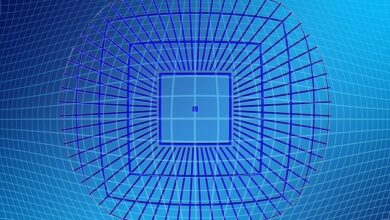Deep Learning Algorithms Enhance Image Recognition Systems

Deep learning algorithms have revolutionized the world of image recognition systems, propelling them to new heights of accuracy and efficiency. These sophisticated algorithms, inspired by the human brain’s neural networks, have unlocked remarkable capabilities for computers to perceive and interpret visual data. In this article, we will delve into the details of how deep learning algorithms enhance image recognition systems, unveiling the astonishing advancements they bring to the table.
At its core, deep learning is a subset of machine learning that employs artificial neural networks to process and analyze vast amounts of data. When applied to image recognition, deep learning algorithms excel in identifying patterns, shapes, and features within images, enabling machines to recognize objects, people, and even emotions with exceptional precision.
One key aspect that sets deep learning algorithms apart is their ability to learn and improve from experience without explicit programming. By using layers of interconnected artificial neurons, deep learning models can automatically extract relevant features from raw image data, reducing the need for manual feature engineering. This flexibility allows the algorithms to adapt and evolve, continually enhancing their recognition capabilities.

The results achieved by deep learning algorithms in image recognition are truly awe-inspiring. They have surpassed human-level performance in various tasks, such as object detection, facial recognition, and scene understanding. Through extensive training on enormous datasets, these algorithms become adept at classifying and labeling images, making them invaluable in fields like autonomous vehicles, medical imaging, and surveillance systems.
By harnessing the power of deep learning algorithms, image recognition systems can now identify intricate details and subtle nuances that were previously challenging or impossible for machines to discern. They can differentiate between similar objects, detect anomalies, and make accurate predictions based on visual cues. This has opened up exciting possibilities in diverse domains, including e-commerce, security, healthcare, and entertainment.
Deep learning algorithms have emerged as game-changers in the realm of image recognition systems. Their ability to learn, adapt, and uncover complex patterns within images has propelled the field forward, enabling unprecedented levels of accuracy and efficiency. As these algorithms continue to evolve and improve, we can expect even more astonishing advancements in image recognition technology, empowering machines to perceive the visual world with remarkable acuity.
Revolutionizing Visual Intelligence: Deep Learning Algorithms Propel Image Recognition to New Heights
In today’s digital era, the field of image recognition has witnessed a remarkable transformation. Thanks to cutting-edge deep learning algorithms, visual intelligence has been revolutionized, pushing the boundaries of what was once thought possible. This article dives into the fascinating world of deep learning and its impact on image recognition, unravelling the advancements that have propelled this technology to new heights.
Imagine a computer with the ability to see and understand images just like a human brain does. Deep learning algorithms make this incredible feat achievable. By mimicking the neural pathways of the human brain, these algorithms can recognize patterns, extract features, and classify images with astonishing accuracy.
At the heart of deep learning lies the concept of artificial neural networks (ANN). These networks are composed of interconnected layers of artificial neurons that process information. Similar to how our brain processes visual stimuli, ANNs learn from vast amounts of labeled data, gradually improving their ability to recognize objects, shapes, and even complex scenes.
One of the groundbreaking developments in deep learning is Convolutional Neural Networks (CNNs). Inspired by the visual cortex of animals, CNNs excel in analyzing visual data. They use convolutional layers to extract meaningful features from images, followed by pooling layers to reduce dimensionality. This hierarchical approach enables CNNs to detect intricate details at different levels, thereby enhancing image recognition.
Another crucial aspect driving the progress of deep learning in image recognition is the availability of large-scale datasets. With millions of annotated images, such as ImageNet, researchers can train deep learning models to recognize an extensive range of objects and concepts. This vast amount of data fuels the learning process, enabling algorithms to achieve unprecedented accuracy and robustness.
The applications of deep learning in image recognition are widespread and diverse. From self-driving cars identifying pedestrians and traffic signs to healthcare systems diagnosing diseases from medical images, the potential impact is immense. Additionally, industries like retail, security, and entertainment are leveraging deep learning algorithms to enhance visual search, improve surveillance systems, and develop immersive virtual reality experiences.
Deep learning algorithms have propelled image recognition to new heights, transforming the world of visual intelligence. By simulating the human brain’s neural pathways and leveraging vast datasets, these algorithms can analyze and understand images with unprecedented accuracy. With the rapid advancement of deep learning, we can expect even more innovative applications and exciting breakthroughs in the future. The possibilities are truly awe-inspiring, heralding a new era of visual understanding and unlocking endless opportunities across various domains.
Unveiling the Power of Neural Networks: How Deep Learning Transforms Image Recognition

Have you ever wondered how computers can recognize and understand images? The answer lies in the remarkable technology of neural networks, more specifically, deep learning. In this article, we will dive into the captivating world of deep learning and explore how it revolutionizes image recognition.
Deep learning is a subset of machine learning, inspired by the structure and function of the human brain. It utilizes artificial neural networks with multiple layers to process and analyze vast amounts of data. When it comes to image recognition, deep learning algorithms excel at identifying patterns and extracting meaningful features from images.


Imagine your brain as a complex network of interconnected neurons, constantly processing information and making sense of the world around you. Similarly, deep learning models consist of layers of artificial neurons called nodes. Each node receives inputs, performs calculations, and passes the results to the next layer. Through this intricate network, the model learns to recognize intricate patterns and hierarchies within images.
The transformative power of deep learning in image recognition becomes evident when we consider its ability to learn directly from raw data. Unlike traditional computer vision techniques that rely on manual feature extraction, deep learning algorithms automatically learn relevant features from the data itself. This means that the model can discern important aspects of an image without explicit human intervention, leading to more accurate and efficient image recognition systems.
One of the key components of deep learning for image recognition is the convolutional neural network (CNN). CNNs are designed to mimic the visual cortex of the human brain, enabling them to efficiently process and analyze visual data. By using layers of convolutional filters, CNNs can detect edges, textures, shapes, and other visual attributes within images. These learned features are then combined to recognize objects, classify images, or even generate new visual content.
The advancements in deep learning have profoundly impacted various fields, including healthcare, autonomous vehicles, and security systems. Medical professionals can now leverage deep learning models to assist in diagnosing diseases from medical images with remarkable accuracy. Self-driving cars equipped with deep learning algorithms can detect and recognize pedestrians, traffic signs, and obstacles, enhancing safety on the roads.
Deep learning has unleashed the true potential of neural networks for image recognition. Through its ability to learn directly from data and extract meaningful features, deep learning algorithms have revolutionized the way computers perceive and understand visual information. As we continue to explore the depths of this technology, the possibilities for image recognition and its applications are boundless.
From Pixels to Patterns: Deep Learning Algorithms Revolutionize Image Recognition Systems
Article:
Have you ever wondered how computers are able to recognize and understand images? It’s a fascinating process that has seen tremendous advancements in recent years, thanks to the groundbreaking technology of deep learning algorithms. These algorithms have revolutionized the field of image recognition and opened up new possibilities for various industries.
In the past, image recognition systems relied on handcrafted features and traditional machine learning techniques. Engineers would painstakingly design specific rules and algorithms to identify patterns in images. However, this approach had limitations as it required experts to manually extract and select relevant features, which often resulted in suboptimal performance and restricted the system’s ability to handle complex and diverse datasets.
Enter deep learning algorithms, inspired by the workings of the human brain. These algorithms use artificial neural networks composed of interconnected layers of virtual “neurons” to automatically learn and extract features from raw pixel data. By analyzing vast amounts of labeled images, these algorithms can identify intricate patterns and representations that were previously difficult to capture using traditional methods.

The power of deep learning lies in its ability to uncover hidden relationships and hierarchies within data. Each layer of neurons learns to detect increasingly complex features, starting from simple edges and shapes to more abstract concepts like textures, objects, and even entire scenes. This hierarchical representation allows deep learning models to achieve remarkable accuracy in recognizing and classifying images across a wide range of domains.
With the rise of deep learning algorithms, image recognition systems have witnessed unprecedented advancements. They can now accurately identify objects, faces, gestures, and even emotions with astonishing precision. From self-driving cars that recognize pedestrians and road signs to medical imaging systems that aid in diagnosing diseases, deep learning has found applications in numerous fields.
Moreover, these algorithms continuously improve over time through a process known as training. By exposing the model to more diverse and comprehensive datasets, it becomes more adept at recognizing and classifying images accurately. This adaptability makes deep learning algorithms versatile and future-proof, ensuring their relevance in the rapidly evolving world of image recognition.
Deep learning algorithms have ushered in a new era of image recognition systems. By harnessing the power of neural networks and their ability to learn from raw pixel data, these algorithms can decipher complex patterns and representations with remarkable accuracy. From enhancing security systems to advancing medical diagnostics, the impact of deep learning on image recognition is awe-inspiring. As technology continues to evolve, we can only imagine the incredible possibilities that lie ahead in this exciting field.
The Rise of Smart Machines: Deep Learning Algorithms Supercharge Image Recognition Technology
Have you ever wondered how your smartphone can instantly recognize faces in photos or how self-driving cars are able to identify objects on the road? It’s all thanks to the remarkable advancements in image recognition technology powered by deep learning algorithms. In this digital age, smart machines armed with these algorithms are revolutionizing our lives, transforming the way we interact with technology.
Deep learning, a subset of artificial intelligence (AI), has taken image recognition to unprecedented heights. Traditional methods relied on handcrafted features, where human experts manually extracted relevant information from images. However, the limitations of this approach became evident as it struggled to handle complex data patterns and variations. Enter deep learning algorithms, inspired by the structure and functioning of the human brain.
These algorithms leverage neural networks, which are intricate systems of interconnected nodes that process information. Through a process called training, these networks learn to recognize and classify patterns within vast amounts of data. By analyzing millions of labeled images, deep learning algorithms become adept at identifying specific objects, shapes, textures, and even subtle nuances that were previously challenging for machines.
One of the greatest achievements of deep learning in image recognition is convolutional neural networks (CNNs). These specialized networks have transformed the way machines perceive and understand images. CNNs divide an image into smaller overlapping regions and analyze them individually, capturing hierarchical features at different levels. This mimics the way our visual cortex processes visual information, enabling machines to replicate human-like image recognition capabilities.
The impact of deep learning algorithms on image recognition is awe-inspiring. Not only can they identify objects accurately, but they can also detect emotions, estimate poses, and perform facial recognition with exceptional precision. This has unlocked a wealth of possibilities across various industries. From healthcare to security, retail to manufacturing, image recognition technology is enhancing efficiency, improving safety, and delivering personalized user experiences.
The rise of smart machines empowered by deep learning algorithms has supercharged image recognition technology. With their ability to learn from massive datasets and discern intricate patterns, these algorithms have brought about a new era of intelligent machines capable of understanding and interpreting the visual world like never before. As we continue to witness advancements in this field, the potential for innovation and transformative applications is boundless. Brace yourself for a future where smart machines seamlessly interact with us based on their unparalleled image recognition abilities.




